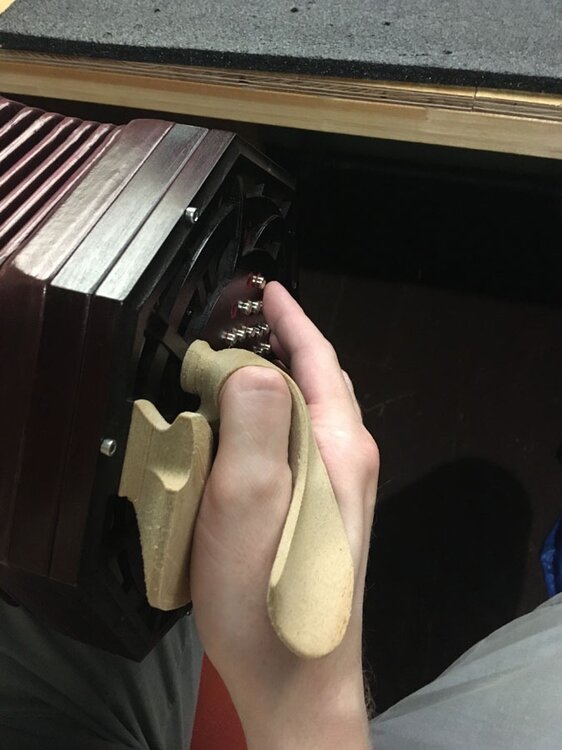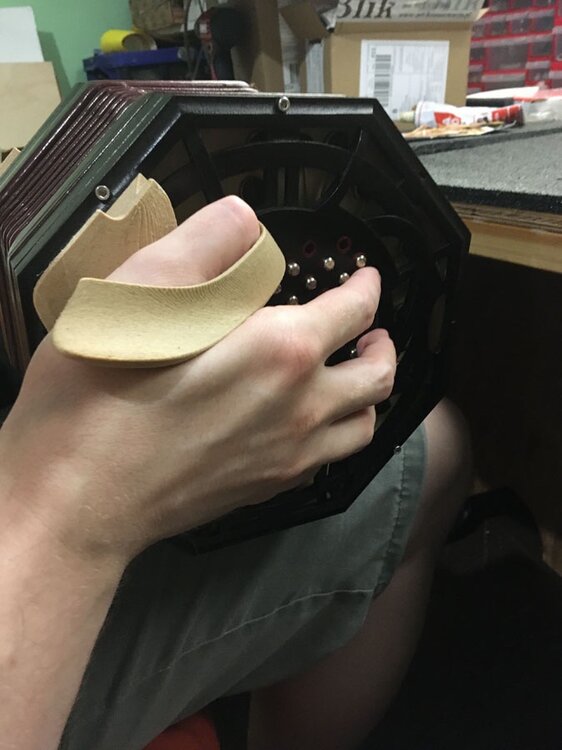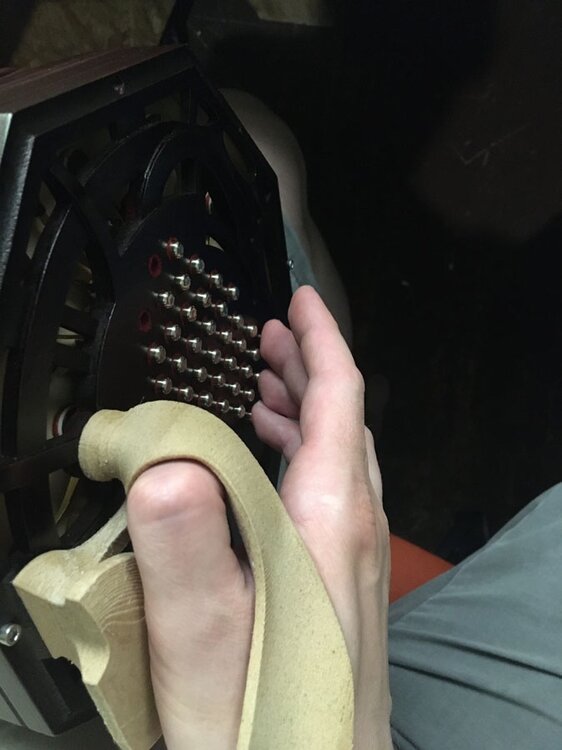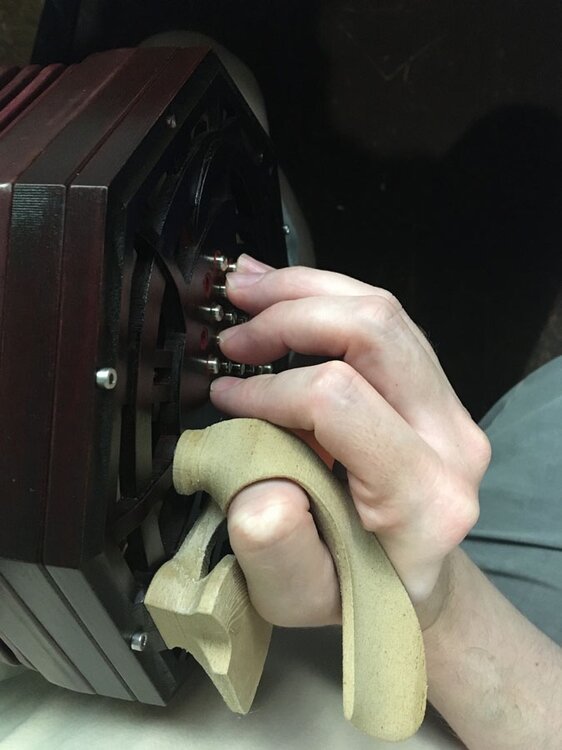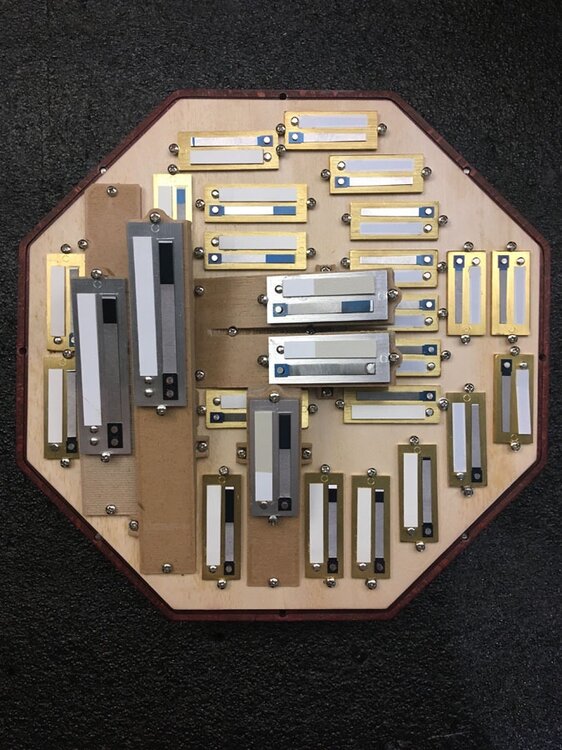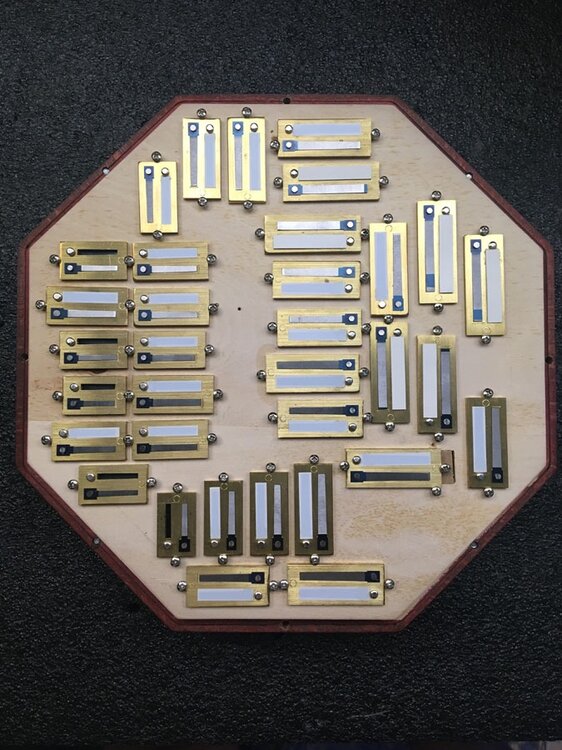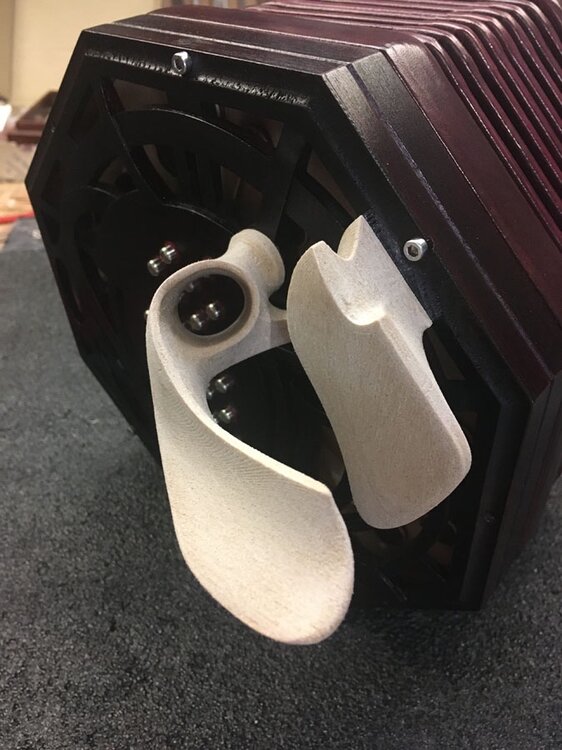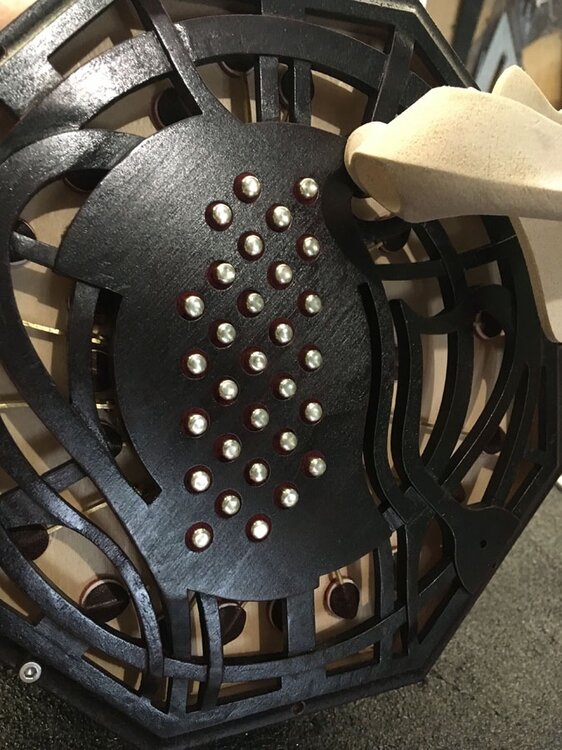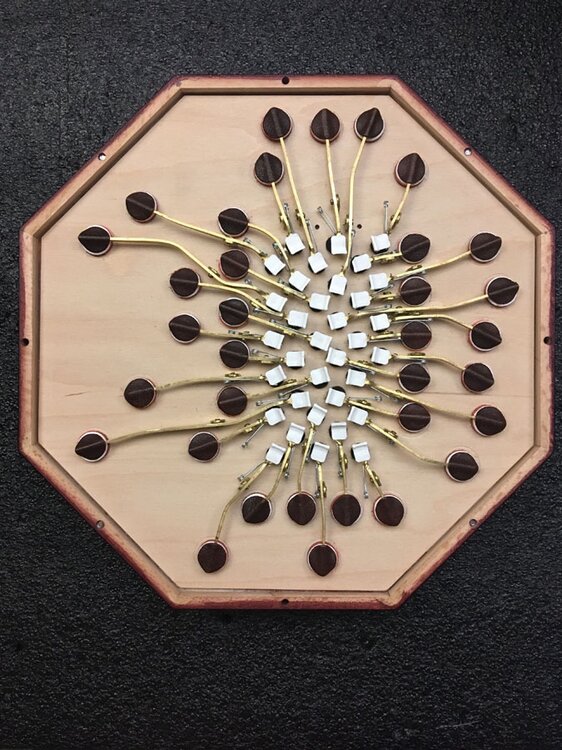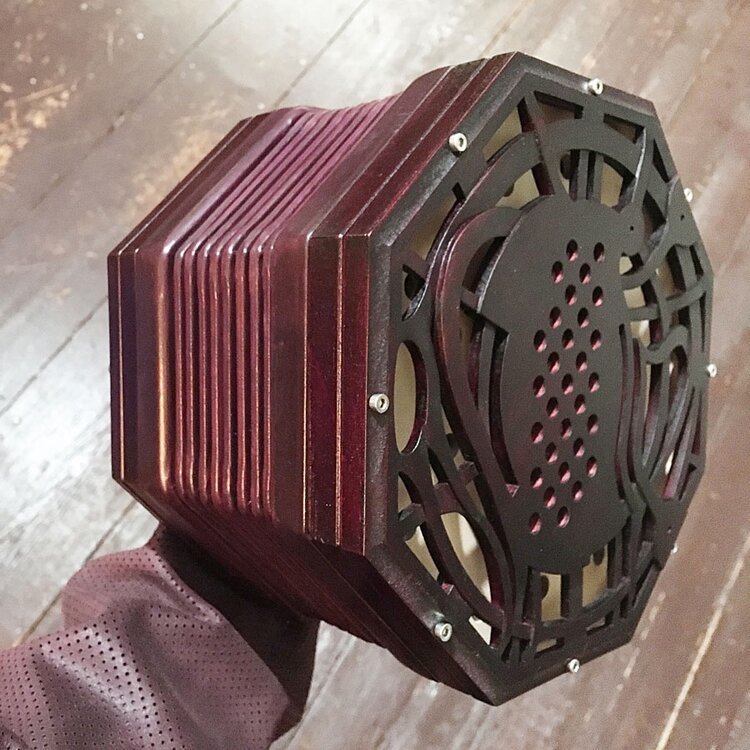-
Posts
658 -
Joined
-
Last visited
Everything posted by Łukasz Martynowicz
-
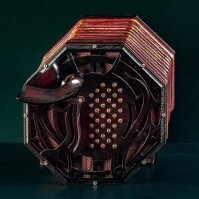
Building Hayden Duett
Łukasz Martynowicz replied to Łukasz Martynowicz's topic in Instrument Construction & Repair
Ok, so here is a very short video of the freedom and control this handle design gives. No actual playing yet, as a) it is not tuned yet, and b) I have to relearn how to play first https://youtu.be/rd8M5eeYMWk @dabbler: buttons, button interfaces and pads are printed with simple "matt PLA", as there are no special concerns regarding durability or longevity of the material for those parts, you won't submerge the concertina anyways (and I don't expect to move to high humidity area any time soon either). And no, I won't be lubricating those, there is a layer of felt between the button and the paddle to take care of noise and friction.- 78 replies
-
- 1
-

-
- Construction
- Building
-
(and 2 more)
Tagged with:
-

Building Hayden Duett
Łukasz Martynowicz replied to Łukasz Martynowicz's topic in Instrument Construction & Repair
This is why it is 6mm thick solid wood, and my handle design leaves no force on the fretwork whatsoever - the only contact points are fingers and the "anvil" part of the handle. So I'm pretty confident that it won't snap under normal use conditions. Of course accidents may happen, but there is nothing hard in repairing this in such unfortunate case, benefits of shellac finish.- 78 replies
-
- Construction
- Building
-
(and 2 more)
Tagged with:
-

Building Hayden Duett
Łukasz Martynowicz replied to Łukasz Martynowicz's topic in Instrument Construction & Repair
There will be an air vent lever, but I needed to solve the handle design first (which, in turn, needed a working platform to work on), so it is "to do", I forgot to list it above. It is a bit hard to make picture with hands crossed, but I'll post a short video once the whole thing is finished to show the capabilities of this handle design. Probably within two weeks. On first two attached photos you can see how this works in resting position (bear in mind that forearm angle is caused by trying to make a photo), then next two show examples of extreme reach - all D# pressed and then all Cs with highest F with a pinky. Any "wrap arounds", chords (including whatever 4 finger chords you need) etc are easily reachable all over the place because there is no classic handrest to go in the way and limit the movement of the palm. Thumb does not bear any load, everything rests on the "door handle" part between the thumb and the index finger (under which you "roll" the hand to reach everything), the thumb "strap" works like a thimble and only anchors the hand in relation to the button array. Bellows can be properly operated because the thumb is locked in one plane between the "door handle" and "the anvil" parts but free to swivel back and forth otherwise. What is important is that there is no gymnastics or awkward twisting of the muscles involved (as occur with hand straps because confines of the strap), because both the palm and the wrist are completely free, so it is very easy on the hand. This really resembles "flying hand", just anchored with a thumb thimble. Also, the plane of the thumb is not parallel to the endplates, but at a sharp angle to it, so wrists and arms work in ergonomic way.- 78 replies
-
- 1
-

-
- Construction
- Building
-
(and 2 more)
Tagged with:
-

Building Hayden Duett
Łukasz Martynowicz replied to Łukasz Martynowicz's topic in Instrument Construction & Repair
Reeds are now installed and mostly adjusted for attack speed and volume, only highest reeds need some more adjustments. Lowest reeds have rather complex chambers to achieve immediate response at minimal pressures. The whole thing is fast but heavy, as one expects from box with 62 reeds. Because this project was first designed for a set of larger-than-standard old russian reeds, which were then exchanged for smaller-than-standard DIX reeds it could be a bit smaller. (It is now 8 2/3" but could be about 8"). It weights 2200g. Only those highest reeds, bellows papers, handles staining/polishing and endplate meshes left to do at this point. And learning how to play on it after another 8 months of break...- 78 replies
-
- 3
-

-

-
- Construction
- Building
-
(and 2 more)
Tagged with:
-

Building Hayden Duett
Łukasz Martynowicz replied to Łukasz Martynowicz's topic in Instrument Construction & Repair
Handles are completely non-traditional. Large Haydens are difficult to play with hand straps, so I've designed this. It allows nearly "flying hand", I can comfortably reach entire RH array with practically ANY finger. This enables playing large chords or octaves all over the place - I can use my pinky at the top or index finger for D# easily. The "door handle" part substitutes strap completely in sitting position, even with only single lap support and free floating second side. It is 3d printed with wood filament and will be stained and polished to match the ends.- 78 replies
-
- 1
-

-
- Construction
- Building
-
(and 2 more)
Tagged with:
-

Building Hayden Duett
Łukasz Martynowicz replied to Łukasz Martynowicz's topic in Instrument Construction & Repair
Buttons are metal capped with PLA cores, slightly concave with beveled edge and go all-in into the endplate. They have 3mm travel and are set to 80g of force.- 78 replies
-
- 1
-

-
- Construction
- Building
-
(and 2 more)
Tagged with:
-

Building Hayden Duett
Łukasz Martynowicz replied to Łukasz Martynowicz's topic in Instrument Construction & Repair
Mechanisms are non-traditional. Some of the levers were too short for classic button-lever interface, so mine are decoupled - buttons press on the levers and are confined by a collar at the endplate side. Button cores, lever interfaces and pad "papers" are 3d printed.- 78 replies
-
- 1
-

-
- Construction
- Building
-
(and 2 more)
Tagged with:
-

Building Hayden Duett
Łukasz Martynowicz replied to Łukasz Martynowicz's topic in Instrument Construction & Repair
- 78 replies
-
- 2
-

-
- Construction
- Building
-
(and 2 more)
Tagged with:
-

Building Hayden Duett
Łukasz Martynowicz replied to Łukasz Martynowicz's topic in Instrument Construction & Repair
Ok, so it's major update time. When I left the work all those years ago, the endplates were still a mess. This is how they look after dozens more hours of filing.- 78 replies
-
- 2
-

-

-
- Construction
- Building
-
(and 2 more)
Tagged with:
-

Chromatic notation for Hayden duet
Łukasz Martynowicz replied to Łukasz Martynowicz's topic in Teaching and Learning
If you have any questions on how to actually use this Musescore fork, feel free to ask, as it comes without any instructions and has some non-intuitive elements to it at first preparation/template making stage. -
When life presents such a dillema to me I come at it from a different angle - how will I feel afterwards with possible outcomes. If you don’t accept and nobody get’s sick afterwards you have just lost a gig and some money, you will forget about it in a week or two. If someone does get sick, you won’t and your life goes on uninterrupted - you can pat yourself in the back for making good decision. If you go and nobody get’s sick, you get some money and a nice if a bit scary evening and a week or two living in uncertainty and stress if you are susceptible to such worries. And if you go and do get sick, you will forever regret going, especially if you propagate this desease on your family or friends. Now because all those eventualities have unknown weights and our brains realy and fundamentally suck at probabilities, there is no room for rationality here, only for psychology - personally, are you scared and seek confirmation with this post, or have you already decided on going because COVID is no big deal and seek confirmation that there is nothing to worry about?
-

People who play multiple systems
Łukasz Martynowicz replied to Sean M's topic in General Concertina Discussion
Seconded on "Musix" by Shiverware. I use it regularily on train journeys for fingering practice/learning new material without annoying fellow passengers. If you (Sean) are interested in CBAs you can get a hang of the differences in fingering between C- and B-system within the same neat package. One thing though - default orientations are designed for devices lying flat, so trying to hold your phone to mimic concertina orientation doesn't work out-of-the-box, but fortunately you can design your own presets so this obstacle can be overcome. Even on small phone you can fit one entire side of Elise with true "buttons" spacing, thus train your muscle memory for the real instrument. -

People who play multiple systems
Łukasz Martynowicz replied to Sean M's topic in General Concertina Discussion
Amelie soundtrack is exactly what got me into duets and most of my repertoire is adapted from accordions. Haydens are very intuitive for typical oom-pah chord progressions and Elise is good enough (although very limiting) entry point for learning to play this kind of music. However, this is also the exact reason why I find available upgrade path problematic - both Troubadour and Peacock from Concertina Connection lack LH A4, which occurs a lot in accordion style oom-pahs (and you will use it a lot on Elise for this kind of music). Personally I find missing a single note out of accompaniment circle of otherwise rich, three note chords utterly annoing and arrangement breaking. So, for me, this cuts down purchase worthy and reachable upgrade options solely to Beaumont. If you also consider CBA to be an option, then take a look at Hohner Nova I 49f - this is the smallest free-bass accordion, allowing duet-like countermelody arrangements. Similarily to duets, it has the same button layout for both hands. -

People who play multiple systems
Łukasz Martynowicz replied to Sean M's topic in General Concertina Discussion
I have played both Anglo and Hayden for a couple of months during my transition between systems, but then have abandoned anglo altogether simply because I found duets more suiting my needs. But I had no problem switching instruments during practice session, as the nature of those two systems is so much apart, that there was no confusioin at all. But, as years long owner of Elise I must ask - what repertoire exactly are you thinking of? Because the main difference in instrument limitations between anglos and duets isn't bisonoric vs unisonoric nature of the instrument, but the universal range of notes on the anglo vs model specific range of notes on duets - up to a level of "standard" 46 or Beaumont 52 keys you will always desire more, as you will run into many arragements problems. And while Hayden is a great system and Elise is an ok entry level instrument, it is, at it's core, a diatonic instrument dressed up into chromatic outfit. So be aware, from the very start, of the prices and note ranges of upgrade options and check what exact range you will need for your final desired repertoire. -

Looking for Hayden duets
Łukasz Martynowicz replied to datnameis's topic in General Concertina Discussion
Nowadays you have the following options, in price order: Stagi, then Troubadour & Peacock from Concertina Connection, then Beaumont from Morse Concertinas, and finally Wakker H-1 & H-2. Note range wise the list goes as follows: 36 button Troubadour, 42 Peacock, 46 Stagi and Wakker H-1, 52 Beaumont, 65 Wakker H-2. That is all. -

Maybe of interest to Hayden Players
Łukasz Martynowicz replied to Graham Collicutt's topic in General Concertina Discussion
I actually have two tunes causing trouble by this. The feature I talk about is even more pronounced on slanted Park layout (similar hex based layout with whole tone/minor third/perfect fourth instead of Hayden's whole tone/perfect fourth/perfect fifth axes) where you play all major, minor, seventh, sus4 and augmented chords with a natural middle finger position further from the palm. On a Hayden you play minor and sus4 chords with inverted finger position, with your longest finger closest to the palm, which causes me a lot of troubles with left hand minor chord oom-pahs and arpeggios, because my middle finger attack angle is so skewed (I have very long fingers) and Hayden slant emphasises this problem even further for the left hand. -

Maybe of interest to Hayden Players
Łukasz Martynowicz replied to Graham Collicutt's topic in General Concertina Discussion
Index finger on root, then for major triad middle finger on fifth and ring finger on third. Then ~90 degrees wrist twist gives you index still on root, middle on minor third and ring on fifth. You can also play first inversion of IVmaj mid twist (at ~45 degrees) with same fingering. On a „proper Hayden” row shift is larger so that this wrist twist is bigger and grouping my fingers to do the same feels uncomfortable. The reason I find this usefull is that you can play oom-pahs and some arpeggios using same (mirrored for arpeggios) wrist-gimball-only movement which enable „tremor amplifiying” technique of fast playing. Of course on concertinas there is also hand strap preventing you from doing this, but nevertheless I find it a feature of Striso angles, not the bug. -

Maybe of interest to Hayden Players
Łukasz Martynowicz replied to Graham Collicutt's topic in General Concertina Discussion
One aspect of his offset that I actually like - you can play minor and major triads with the same finger on the root note, which makes a typical pop progressions easier to finger, but require wrist twist that is way harder on concertinas. This also shows that he started working on his grid with squares instead of hexagons and then skewed them slightly. -

Maybe of interest to Hayden Players
Łukasz Martynowicz replied to Graham Collicutt's topic in General Concertina Discussion
Would be interesting if not for this ugly synthetic tone. And one funny thing - from the description on Kickstarter site it seems like this guy reinvented Wicki-Hayden for the n-th time and has no clue about previous kickstarter projects with the same layout, let alone historical inventors. -

Chromatic notation for Hayden duet
Łukasz Martynowicz replied to Łukasz Martynowicz's topic in Teaching and Learning
One other comparison, from musicnotation.org, showing how chords look like compared to traditional notation, my chosen one is directly below traditional, Parncutt 6-6: http://musicnotation.org/pdf/comparisons/Triads.pdf -

Chromatic notation for Hayden duet
Łukasz Martynowicz replied to Łukasz Martynowicz's topic in Teaching and Learning
So here is an example, just couple of simple bars. This is a continuous staff, each four lines are F, G, A, B of consecutive octaves, I have left cleffs for you to orient yourself, and added a quick reference of where natural notes are on. I use color coded notes because on continuous staff there sometimes is overlap of LH and RH lines and all black noteheads cause a mess. Now it should be clearly visible how this system is a natural pair for Hayden keyboard. @David: that is a valid concern regarding my chosen system as you can see in linked example. However, chromatic notations come in certain "families" ('6-6' in this particular case, you can find out more at musicnotation.org), with different graphical details, some designed specifically to adress this confusion. Musescore can represent some of them. The original source for the fork, Clairnote page, has two subsystems, SN and DN exactly to lessen the confusion if someone wants to remain "bilingual", as DN uses hollow/full noteheads for pitch instead of length of note. I have chosen this particular over more distinct alternatives exactly because I needed to remain bilingual. @Thread: Of course, to each their own. As I said, I merely share the sources to those who might be interested once there finally is a way to easily translate systems so that "score availability" argument is no longer valid (at least not so much as six years ago, when I first raised the topic here on c.net). I have been raised in QWERTY tradition and have never felt the need to switch to Dvorak or other alternatives (which in case of Poland is less abstract topic than it seems, as we had a period of competing implementations of missing symbols and I actually had to retrain muscle memory for modifier key when I switched from PC to MAC), but I do find sticking to Imperial units over adapting metric system a bit... stubborn. Including food recipes :D And as a graphic designer there is no way anybody can convince me, that US paper sizes shouldn't burn in hell :P notations comparison.pdf -
I’m sharing this in case anyone else is in similar position and will find this usefull, not to preach to people who feel comfortable with traditional notation. Before my long break from concertinas I have come to realize, that I deeply loathe western music notation and it’s overcomplicated and convoluted nature. The rhytmic part works just fine, but non-proportional vertical pitch placement and non-repetitive octave positioning makes it impossible for me to sight read it thus limiting my options only to scores I can fully memorize, which in my case simply does not work for more advanced duet repertoire. The answer to this was chromatic notation - in which I fell in love instantly. Combined with isomorphic keyboards such notation finally made both music and music theory understandable and I could sight read it fluently after just a day of getting acquainted with my chosen system. But there was one huge problem - back then there was no software for easy convertion from traditional to chromatic, one had to use lext based Lilypond or graphic software to create scores and the only option with playback capabilites was percussion track workaround in pricy Finale - all options tedious and thus practically useless... But no more! To my delight a fork of Musescore2 was made during my absence, which enables the use of many of existing chromatic notation systems! And now I’m like a kid in a candystore, because I can now convert ANY sheet music available in musicXML format in just few clicks! But enough about my personal story. There is one notation system, that I find particularily straightforward when used with Hayden keyboard - Parncutt 6-6 Tegragram http://musicnotation.org/system/6-6-tetragram-by-richard-parncutt/ In it’s essence, it is a piano roll with a twist - assignment of naturals to spaces/lines shifts at semitones, just as rows in Hayden, making it very straightforward for me to sight read it. Moreover, this Musescore fork allows not only staff adjustment, but also colorcoding notes, so now I can have LH and RH lines, including overlap zone, in true vertical octave positions without any ambiguity (this however requires some manual work with reversing and scaling stems properly, but this takes about 10 mins for 50 bars). Now I can finally directly see how accompaniment relates to melody and how harmonies are formed between hands without having them mentally translated - being a graphic designer by trade I’m very sight oriented person. The fork can be downloaded here: https://clairnote.org/dn/software-musescore/ Unfortunatelly ready to install pre-compiled version is only available for Macs and you have to compile it yourself for Windows or Linux. The second drawback is that there seem to be no active development going on and the app itself is now six years old, there are only very limited instructions for it and it is a bit buggy, but nothing game breaking if you save often.
-

Concertina vs accordion reeds
Łukasz Martynowicz replied to Jim2010's topic in General Concertina Discussion
Thanks, that was informative. From a perspective of a Hayden player I would say that Crane system is half way there: it is fairly logical within an octave and chords aren’t „all over the place”. It has some resemblance to 3-row variants of accordion B- and C-systems in that you have different but limited shapes of chords depending on row of the root note. On the Crane however it all goes out the window when you go up an octave - same chord octave higher is fingered entirely differently. @RAc while it is true what you say about „music theory coming alive” in this example, it is also true that in order to construct chords on a Crane one has to already know music theory and how to construct every chord he wishes to play. That is not the case on isomorphic keyboards: the layout itself teaches you theory! (That of course includes the simplest isomorphic layout of them all - bleached and leveled, entirely linear version of piano keyboard:) )That is what I find most usefull about them - all you need to know to play a chord is it’s universal shape and root note. You get all other information directly from your fingers. -

Concertina vs accordion reeds
Łukasz Martynowicz replied to Jim2010's topic in General Concertina Discussion
Seconded, I have a dent in my A3 on the left and A4 on the right, that is enough to reposition my hands if I ever get lost. However, since I begun using thumb straps those dents aren’t really necessary anymore, as my static thumb position and muscle memory are enough to never get lost. One word about Hayden isomorphism. While I love it and not really having to learn anything about different keys to play in them is great, it has one quite significant drawback: if you run into a phrase that is awkward/difficult/impossible to finger smoothly, then you cannot transpose to different key in search of easier fingering, they are all the same by definition. This of course translates to having to step out of your comfort zone regularily and naturally advances your playing and/or arranging skills, but is nevertheless worth to note. This also translates to Haydens not really having „home position” and semi-constant finger-note relation known from Anglos, as which finger goes where at which point depends on exact phrase, not general note. And about chord shapes - I don’t know how constant chord shapes are on a Crane (I guess not that much since it is not isomorphic layout), but having distinctly different shapes for mayor/minor/all other chords is a feature, not a bug in isomorphic layouts. For some different type chords having same shapes, as on Anglos for example, one has to remember which exact chords those are. On a Hayden you don’t really care about anything other than purely geometric relations between buttons, both in chords and in melody sequences, as souds are secondary to geometry. On non-isomorphic systems geometry is secondary to sounds. This may be irrelevant for many, especially to those playing by ear, but for me personally this was fundamental to not only to be able to play on concertina fluently, but more importantly, to finally understand music theory. -

Concertina vs accordion reeds
Łukasz Martynowicz replied to Jim2010's topic in General Concertina Discussion
Wakker H-1 and modern Stagi Hayden are standard 46 key boxes. There is note layout chart for every concertina-connection and Wakker concertina on their respective pages on concertina-connection.com. Beaumont layout can be found on buttonbox.com


